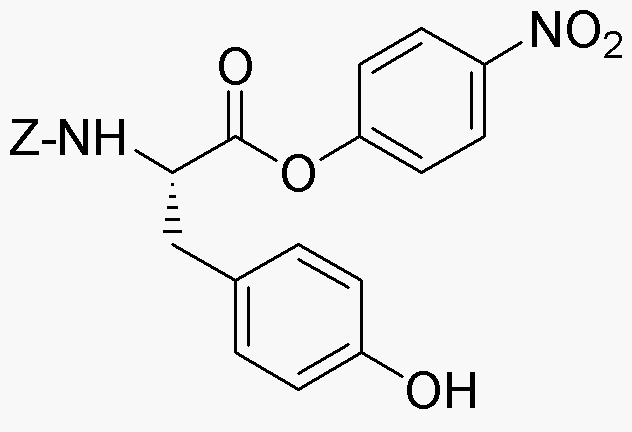Z-L-tyrosine 4-nitrophenyl ester is widely utilized in research focused on:
- Biochemical Research: This compound serves as a substrate in enzyme assays, helping researchers study the activity of various enzymes involved in metabolic pathways.
- Drug Development: Its properties make it a valuable intermediate in synthesizing pharmaceuticals, particularly those targeting neurological disorders due to its structural similarity to neurotransmitters.
- Protein Engineering: Used in the modification of proteins, this ester can enhance the solubility and stability of therapeutic proteins, improving their efficacy in medical applications.
- Analytical Chemistry: It acts as a standard in chromatographic techniques, allowing for the accurate quantification of tyrosine derivatives in complex biological samples.
- Cosmetic Formulations: The compound is incorporated into skincare products for its antioxidant properties, contributing to formulations aimed at reducing oxidative stress on the skin.
General Information
Properties
Safety and Regulations
Applications
Z-L-tyrosine 4-nitrophenyl ester is widely utilized in research focused on:
- Biochemical Research: This compound serves as a substrate in enzyme assays, helping researchers study the activity of various enzymes involved in metabolic pathways.
- Drug Development: Its properties make it a valuable intermediate in synthesizing pharmaceuticals, particularly those targeting neurological disorders due to its structural similarity to neurotransmitters.
- Protein Engineering: Used in the modification of proteins, this ester can enhance the solubility and stability of therapeutic proteins, improving their efficacy in medical applications.
- Analytical Chemistry: It acts as a standard in chromatographic techniques, allowing for the accurate quantification of tyrosine derivatives in complex biological samples.
- Cosmetic Formulations: The compound is incorporated into skincare products for its antioxidant properties, contributing to formulations aimed at reducing oxidative stress on the skin.
Documents
Safety Data Sheets (SDS)
The SDS provides comprehensive safety information on handling, storage, and disposal of the product.
Product Specification (PS)
The PS provides a comprehensive breakdown of the product’s properties, including chemical composition, physical state, purity, and storage requirements. It also details acceptable quality ranges and the product's intended applications.
Certificates of Analysis (COA)
Search for Certificates of Analysis (COA) by entering the products Lot Number. Lot and Batch Numbers can be found on a product’s label following the words ‘Lot’ or ‘Batch’.
*Catalog Number
*Lot Number
Certificates Of Origin (COO)
This COO confirms the country where the product was manufactured, and also details the materials and components used in it and whether it is derived from natural, synthetic, or other specific sources. This certificate may be required for customs, trade, and regulatory compliance.
*Catalog Number
*Lot Number
Safety Data Sheets (SDS)
The SDS provides comprehensive safety information on handling, storage, and disposal of the product.
DownloadProduct Specification (PS)
The PS provides a comprehensive breakdown of the product’s properties, including chemical composition, physical state, purity, and storage requirements. It also details acceptable quality ranges and the product's intended applications.
DownloadCertificates of Analysis (COA)
Search for Certificates of Analysis (COA) by entering the products Lot Number. Lot and Batch Numbers can be found on a product’s label following the words ‘Lot’ or ‘Batch’.
*Catalog Number
*Lot Number
Certificates Of Origin (COO)
This COO confirms the country where the product was manufactured, and also details the materials and components used in it and whether it is derived from natural, synthetic, or other specific sources. This certificate may be required for customs, trade, and regulatory compliance.


